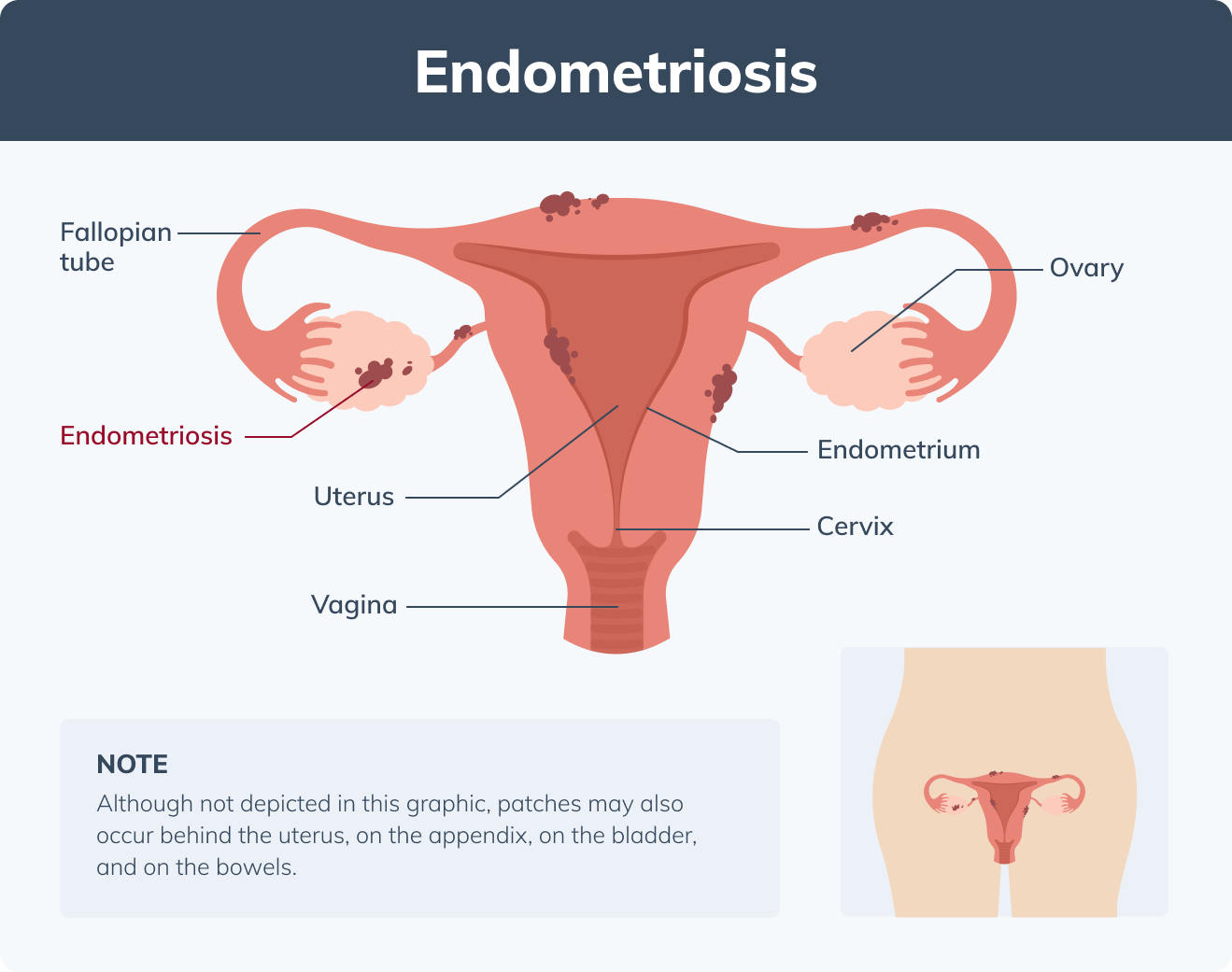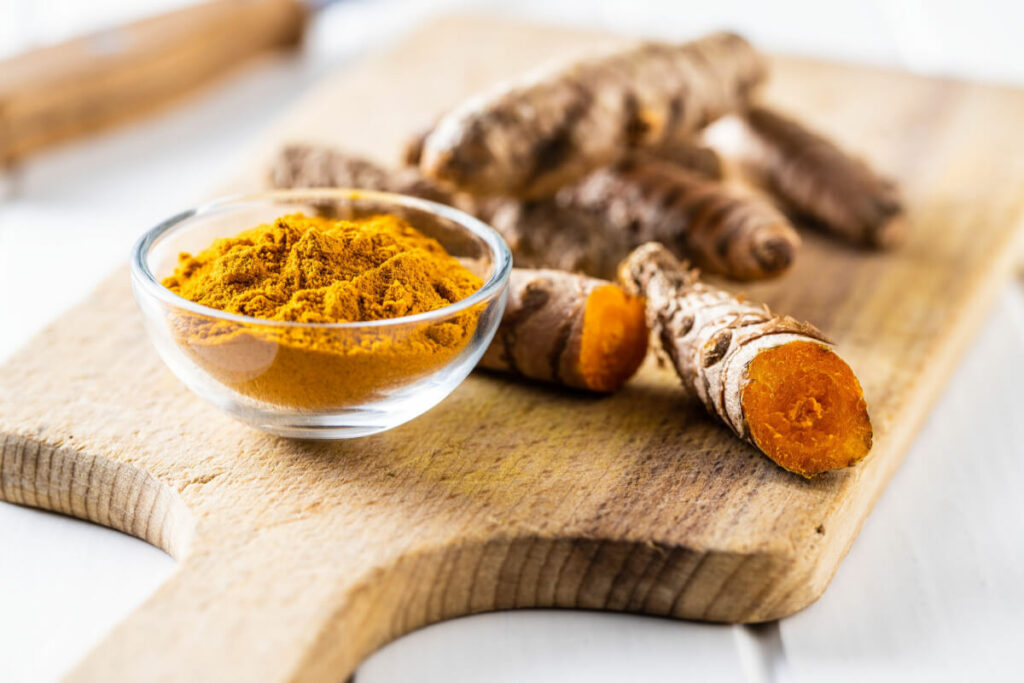Endometriosis is a chronic and often debilitating condition that affects about 10% of females globally. Characterized by infertility and chronic pelvic pain, it can take a toll on both physical and mental health. (9) Continue reading to learn about endometriosis and how to manage endometriosis naturally.

What is endometriosis?
Endometriosis is a painful condition in which the endometrial tissue, the tissue that lines the inside of the uterus, grows in other parts of the body. The patches of endometrial tissue are referred to as implants, nodules, or lesions. (18) These patches are most commonly found:
- Behind the uterus
- On the appendix
- On the bladder
- On the bowels
- On the fallopian tubes
- On the tissues that hold the uterus in place
- On or under the ovaries (14)(18)

Symptoms of endometriosis
Some individuals may not have any symptoms but may experience infertility as the first telltale sign. Common symptoms of endometriosis include:
- Bleeding between periods
- Pain during periods
- Pain during sex
- Pain in the pelvis
- Pain while urinating
- Pain while defecating (12)
FYI: Not everyone who has endometriosis will have the same symptoms. Some individuals may not show any symptoms of endometriosis. (12)
Risk factors for developing endometriosis
Factors that may increase the risk of developing endometriosis include:
- Drinking alcohol regularly
- Getting your period at an early age
- Having a high intake of caffeine
- Having a shorter menstrual cycle (less than 27 days) (12)(20)
How is endometriosis diagnosed
Surgery is the only conclusive way to diagnose endometriosis. Your practitioner will determine if surgery is required based on your symptoms and imaging tests, such as an ultrasound or an MRI. (6)
A laparoscopy is the most common surgery used to make the diagnosis. It involves inserting a tiny tube with a camera, called a laparoscope through a small incision in the abdominal area. The laparoscope is used to find any nodules of endometrium outside of the uterus and determine if endometriosis is present. (6)
Treatment for endometriosis
There is currently no cure for endometriosis; however, there are treatments available to manage symptoms and improve fertility. (15) Medical treatments for endometriosis include:
- Hormone treatments, such as oral hormonal birth control, progestin therapy, and gonadotropin-releasing hormone agonists, medications which cause temporary menopause
- Pain medications, such as ibuprofen and other nonsteroidal anti-inflammatory drugs (NSAIDS)
- Surgery to remove nodules or cut the nerves in the pelvis to relieve endometriosis-related chronic pelvic pain. (18)
In severe cases, a complete hysterectomy may also be performed. This surgery involves the removal of the uterus and sometimes the ovaries and fallopian tubes. (18)
Natural endometriosis treatment
For those that do not want to pursue medical treatment or undergo surgery, there are also some options that may help to reduce endometriosis symptoms naturally.
1. Acupuncture
Acupuncture is a practice that involves inserting thin needles into specific points on the body. The goal of acupuncture is to stimulate the point of insertion in order to create an energetic response. (17)
Although it is not fully understood how, research has shown that acupuncture may have a positive effect on various types of pain. (10)(22) A systematic review and meta analysis conducted in 2016 examined ten clinical studies that looked at the effect of acupuncture on endometriosis-related pain. The review concluded that acupuncture may help to reduce pain and CA-125, (22) a biomarker that is found in individuals with endometriosis. (8)
2. Massage therapy
Massage therapy is a physical treatment that is performed by a regulated professional. It involves manipulating the body’s muscles using the hands, knuckles, forearms, and elbows. (11)
Massage therapy may help reduce pain in those with endometriosis. A clinical trial conducted in 2013 involving 23 women with endometriosis found that there was a significant reduction in endometriosis related pain immediately after receiving massage treatments, with effects lasting 6 weeks after treatment. (19)
3. Yoga
Yoga is an ancient practice that involves physical movement and breath work with the goal of improving physical, mental, and emotional health. (13) There has been a vast amount of research showing that yoga may help manage pain. (5)(16)(21)
A randomized controlled trial conducted in 2018 examined the effects of bi-weekly yoga practice for eight weeks on endometriosis related pain, menstrual patterns, and quality of life in women with endometriosis. The study found that pain levels were significantly lower and quality of life improved in the group that participated in regular yoga, however there was no effect on menstrual patterns. (7) Regularly engaging in yoga may therefore help to reduce pain and improve quality of life for those with endometriosis.
Supplements for endometriosis
Endometriosis is an inflammatory condition. (9) The greater the level of inflammation, the more severe the symptoms a person typically experiences. (3) Therefore, herbs and supplements with antioxidant and anti-inflammatory properties may help to reduce symptoms.
1. Curcumin
Turmeric, a dried powder that comes from the root of the Curcuma longa plant, has been used for centuries for its medicinal properties. The active component responsible for turmeric’s benefits and color is called curcumin. Curcumin has been widely studied for its antioxidant, anti-inflammatory, antigrowth, anti-angiogenesis (prevents the formation of new blood vessels), and anti-metastatic (prevents abnormal cell growth) effects. (1)(3)
Because of curcumin’s antioxidant and anti-inflammatory properties, it may help prevent and manage endometriosis. (3) In an in vitro study (cells tested outside the body) conducted in 2013, researchers found that curcumin may be able to hinder the growth of endometrial cells. (23) However, further research conducted in humans is needed to confirm any beneficial effects for endometriosis.

2. Garlic
Garlic naturally contains compounds that provide anti-inflammatory and antioxidant effects. (2)
A randomized, placebo controlled, triple-blind clinical trial involving 60 women examined the effect of garlic tablets on pain levels in women with endometriosis. The study found a significant reduction in the severity of back, menstrual, and endometriosis related pelvic pain as well as pain with intercourse in the group taking garlic tablets compared to the group taking a placebo. (2)
The bottom line
Endometriosis is a painful, often debilitating condition in which the endometrial tissue grows in other parts of the body. Endometriosis causes pain, heavy periods, and infertility, and can therefore impact the quality of life.
Endometriosis-related pain may be managed naturally through the use of anti-inflammatory supplements, manual therapies performed by licensed professionals, and yoga. Speak to your health care practitioner for testing and guidance before making any changes to your health care regime.
- Aggarwal, B. B., Yuan, W., Li, S., & Gupta, S. C. (2013). Curcumin-free turmeric exhibits anti-inflammatory and anticancer activities: identification of novel components of turmeric. Molecular Nutrition & Food Research, 57(9), 1529–1542.
- Amirsalari, S., Behboodi Moghadam, Z., Taghizadeh, Z., Jafar Abadi, M. N., Sabaghzadeh Irani, P., Goodarzi, S., & Ranjbar, H. (2021). The effect of garlic tablets on the endometriosis-related pains: A Randomized Placebo-Controlled Clinical Trial. Evidence-Based Complementary and Alternative Medicine, 2021, 1–8.
- Arablou, T., & Kolahdouz-Mohammadi, R. (2018). Curcumin and endometriosis: Review on potential roles and molecular mechanisms. Biomedicine & Pharmacotherapy, 97, 91–97.
- Brown, J., Crawford, T. J., Allen, C., Hopewell, S., & Prentice, A. (2017). Nonsteroidal anti-inflammatory drugs for pain in women with endometriosis. Cochrane Database of Systematic Reviews, 2017(5).
- Büssing, A., Ostermann, T., Lüdtke, R., & Michalsen, A. (2012). Effects of yoga interventions on pain and pain-associated disability: A meta-analysis. The Journal of Pain, 13(1), 1–9.
- Eunice Kennedy Shriver National Institute of Child Health and Human Development. How do healthcare providers diagnose endometriosis? NIH. Retrieved March 3, 2022, from https://www.nichd.nih.gov/health/topics/endometri/conditioninfo/diagnose
- Gonçalves, A. V., Barros, N. F., & Bahamondes, L. (2017). The practice of hatha yoga for the treatment of pain associated with endometriosis. The Journal of Alternative and Complementary Medicine, 23(1), 45–52.
- Karimi-Zarchi, M., Dehshiri-Zadeh, N., Sekhavat, L., & Nosouhi, F. (2016). Correlation of CA-125 serum level and clinico-pathological characteristic of patients with endometriosis. International Journal of Reproductive BioMedicine, 14(11), 713–718.
- Maddern, J., Grundy, L., Castro, J., & Brierley, S. M. (2020). Pain in endometriosis. Frontiers in Cellular Neuroscience, 14.
- Madsen, M. V., Gotzsche, P. C., & Hrobjartsson, A. (2009). Acupuncture treatment for pain: systematic review of randomised clinical trials with acupuncture, placebo acupuncture, and no acupuncture groups. BMJ, 338(jan27 2), a3115.
- National Center for Complementary and Integrative Health. Massage therapy: what you need to know. NIH. Retrieved March 3, 2022, from https://www.nccih.nih.gov/health/massage-therapy-what-you-need-to-know
- Parasar, P., Ozcan, P., & Terry, K. L. (2017a). Endometriosis: epidemiology, diagnosis and clinical management. Current Obstetrics and Gynecology Reports, 6(1), 34–41.
- Sengupta, P. (2012). Health impacts of yoga and pranayama: A state-of-the-art review. Health Impacts of Yoga and Pranayama: A State-of-the-Art Review, 3(7), 444–458.
- Stegmann, B. J., Sinaii, N., Liu, S., Segars, J., Merino, M., Nieman, L. K., & Stratton, P. (2008). Using location, color, size, and depth to characterize and identify endometriosis lesions in a cohort of 133 women. Fertility and Sterility, 89(6), 1632–1636.
- Tsamantioti ES, Mahdy H. Endometriosis. . In: StatPearls (Internet). Treasure Island (FL): StatPearls Publishing; 2022 Jan-. Available from: https://www.ncbi.nlm.nih.gov/books/NBK567777
- Tul, Y., Unruh, A., & Dick, B. D. (2010). Yoga for chronic pain management: a qualitative exploration. Scandinavian Journal of Caring Sciences, 25(3), 435–443.
- U.S. National Library of Medicine. Acupuncture. MedlinePlus. Retrieved March 3, 2022, from https://medlineplus.gov/acupuncture.html
- U.S. National Library of Medicine. Endometriosis. MedlinePlus. Retrieved March 3, 2022, from https://medlineplus.gov/endometriosis.html
- Valiani, M., Ghasemi, N., Bahadoran, P., & Heshmat, R. (2010). The effects of massage therapy on dysmenorrhea caused by endometriosis. Iranian Journal of Nursing and Midwifery Research, 14(4), 167–171.
- Wei, M., Cheng, Y., Bu, H., Zhao, Y., & Zhao, W. (2016). Length of Menstrual Cycle and Risk of Endometriosis. Medicine, 95(9), e2922.
- Wren, A. A., Wright, M. A., Carson, J. W., & Keefe, F. J. (2011). Yoga for persistent pain: New findings and directions for an ancient practice. Pain, 152(3), 477–480.
- Xu, Y., Zhao, W., Li, T., Zhao, Y., Bu, H., & Song, S. (2017). Effects of acupuncture for the treatment of endometriosis-related pain: A systematic review and meta-analysis. PLOS ONE, 12(10), e0186616.





